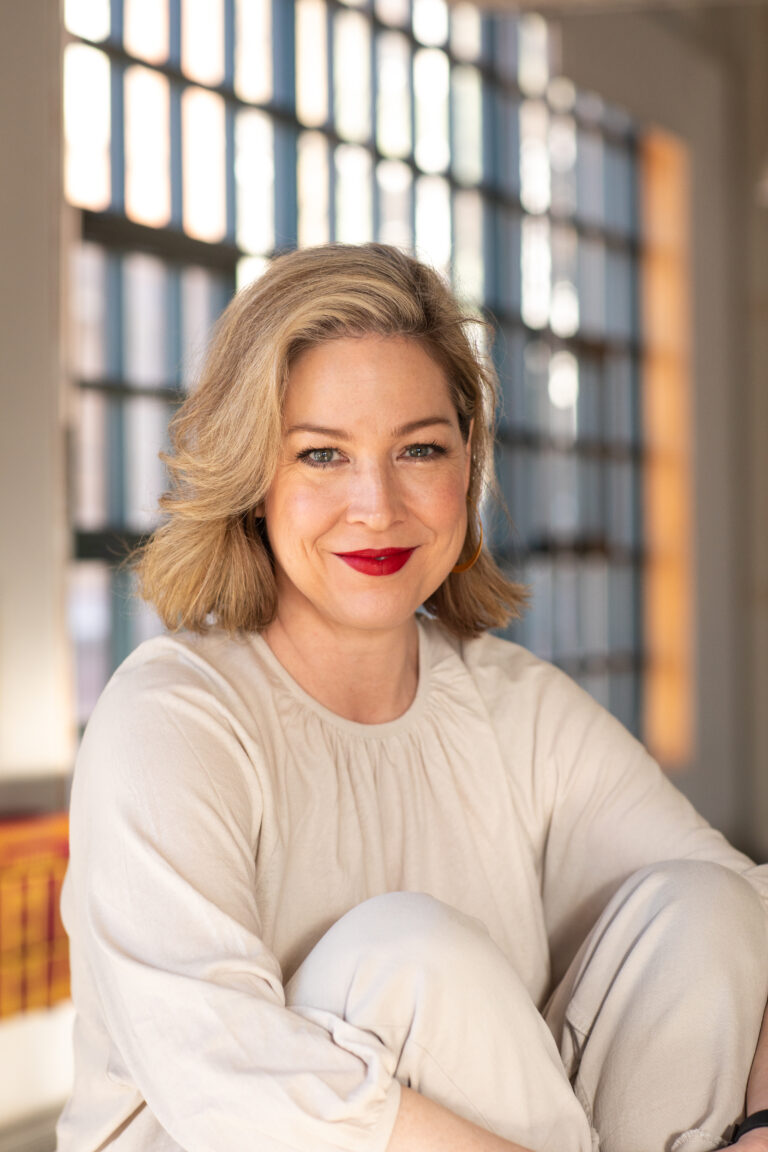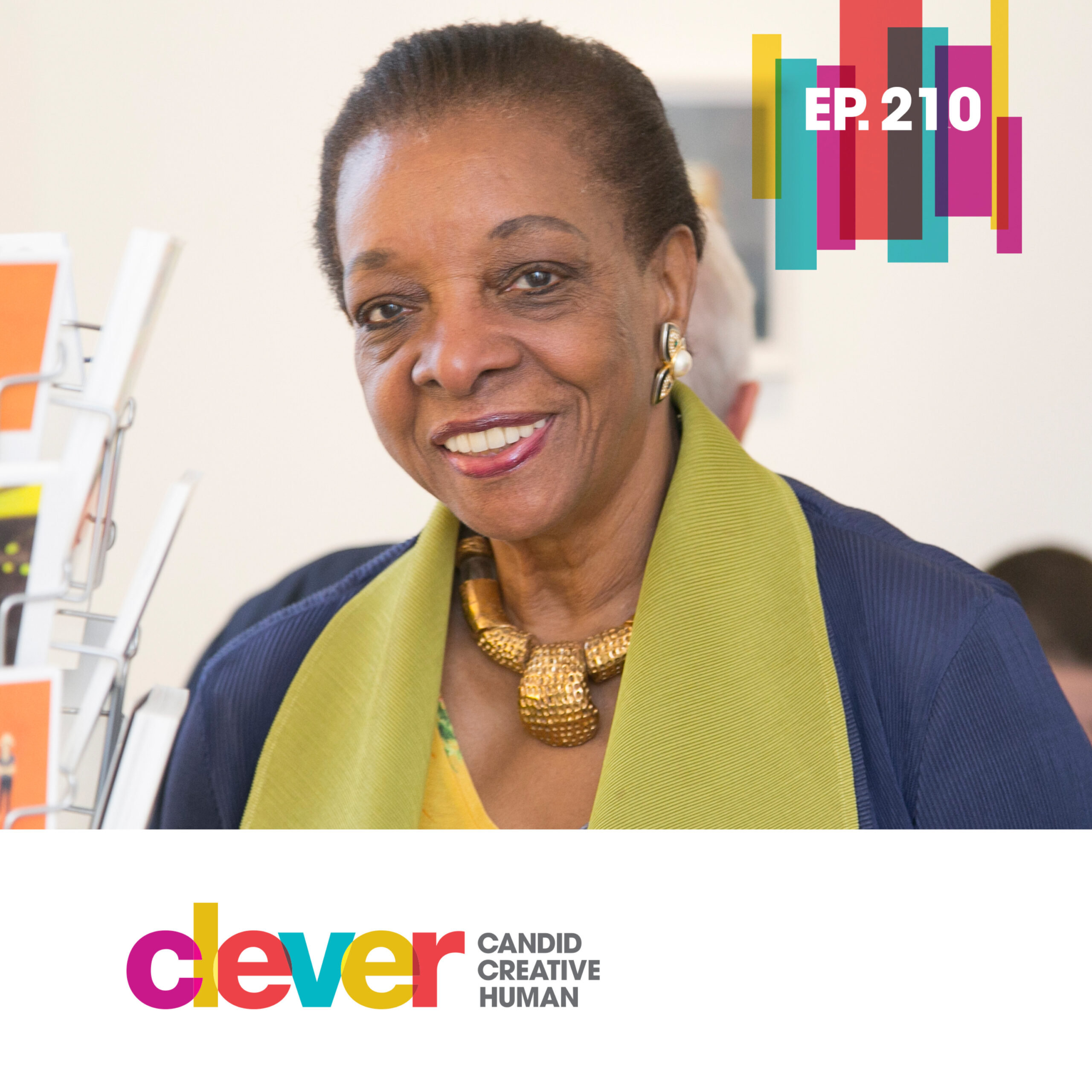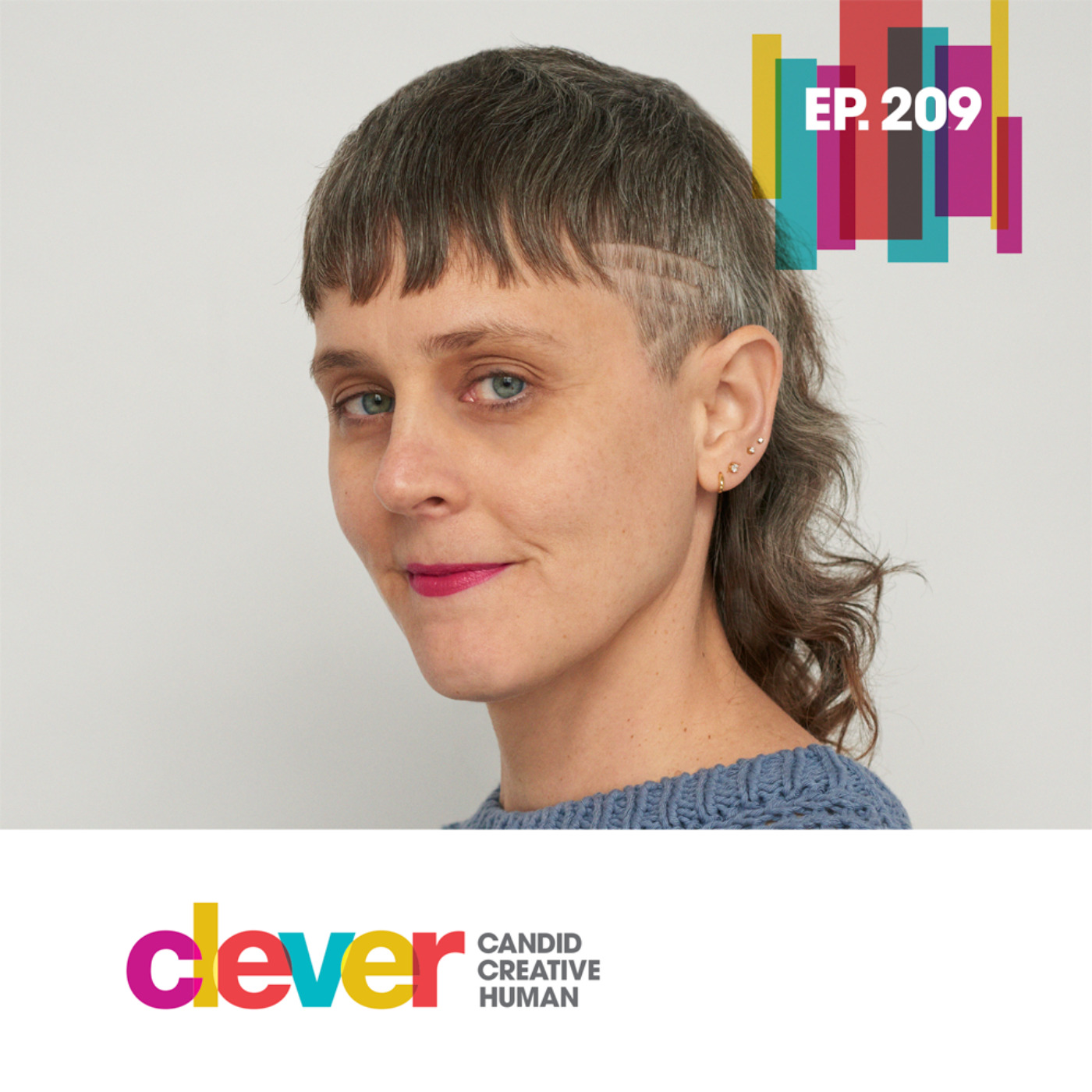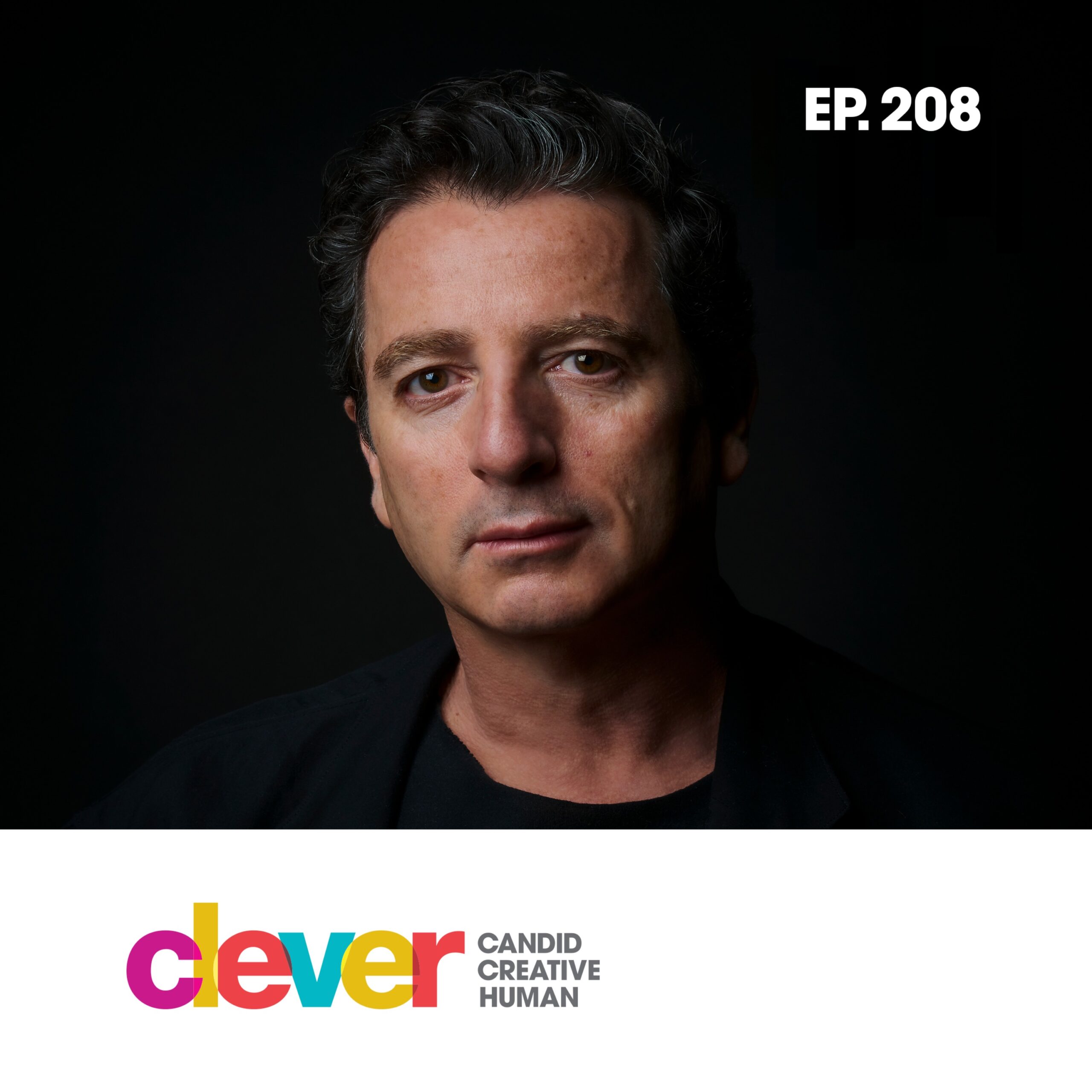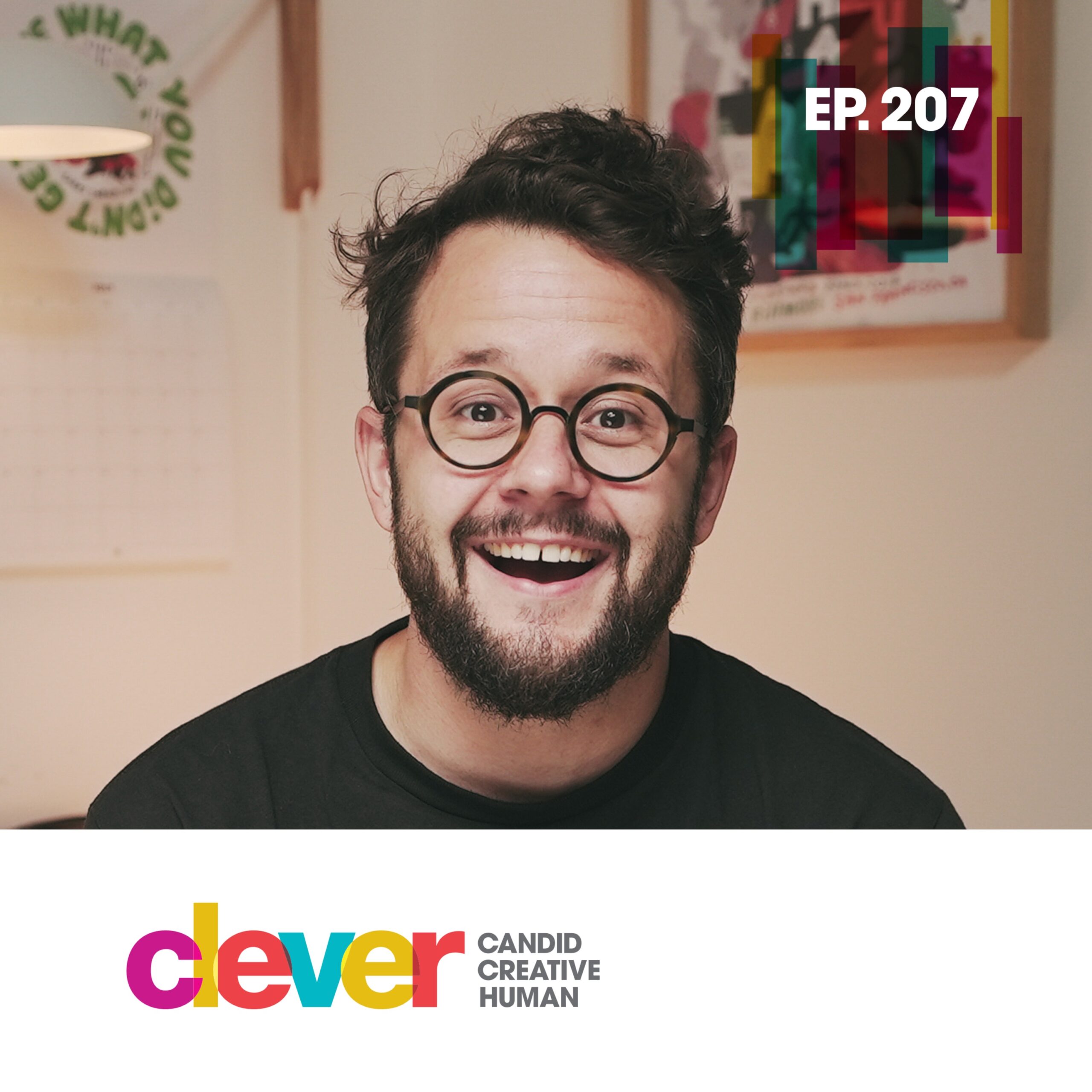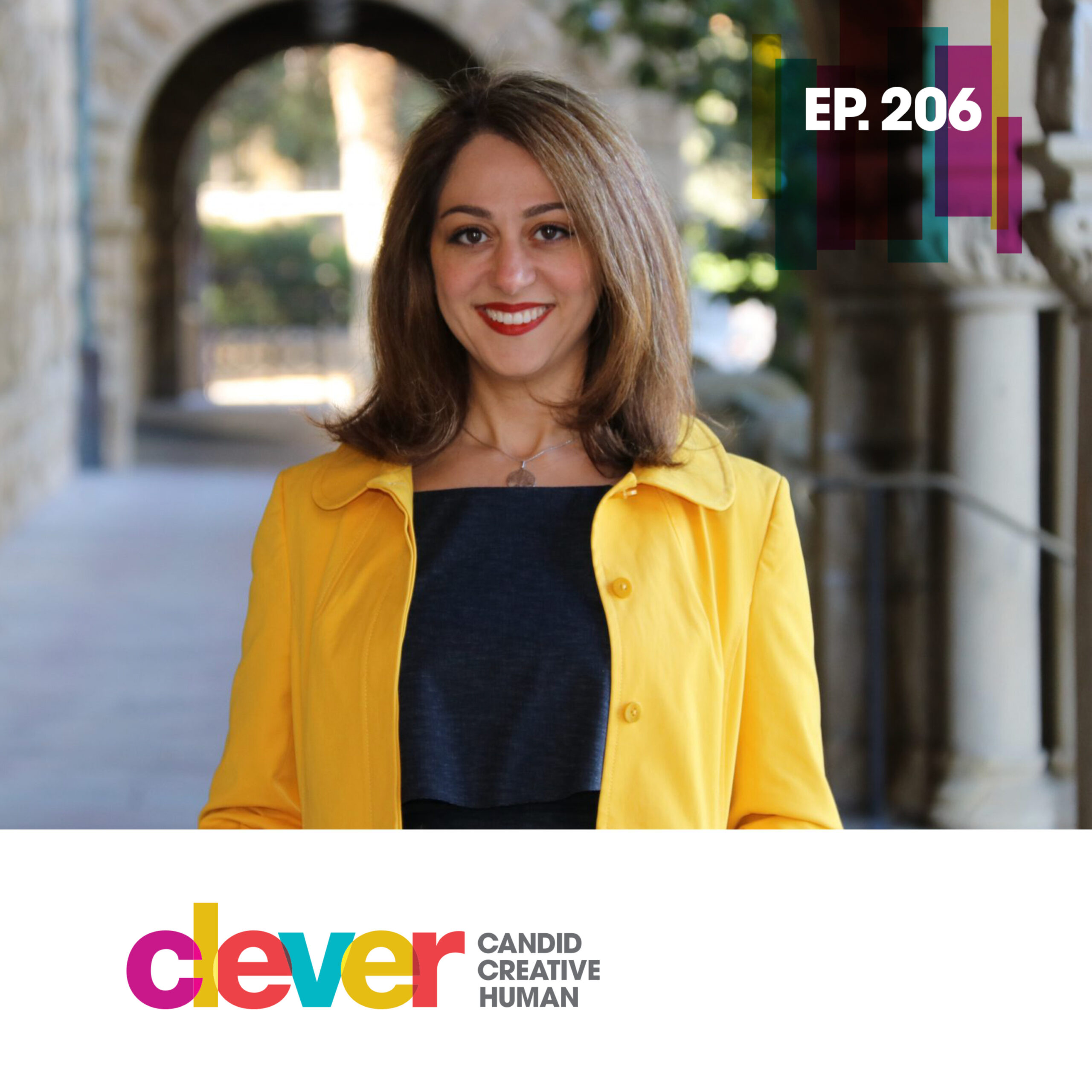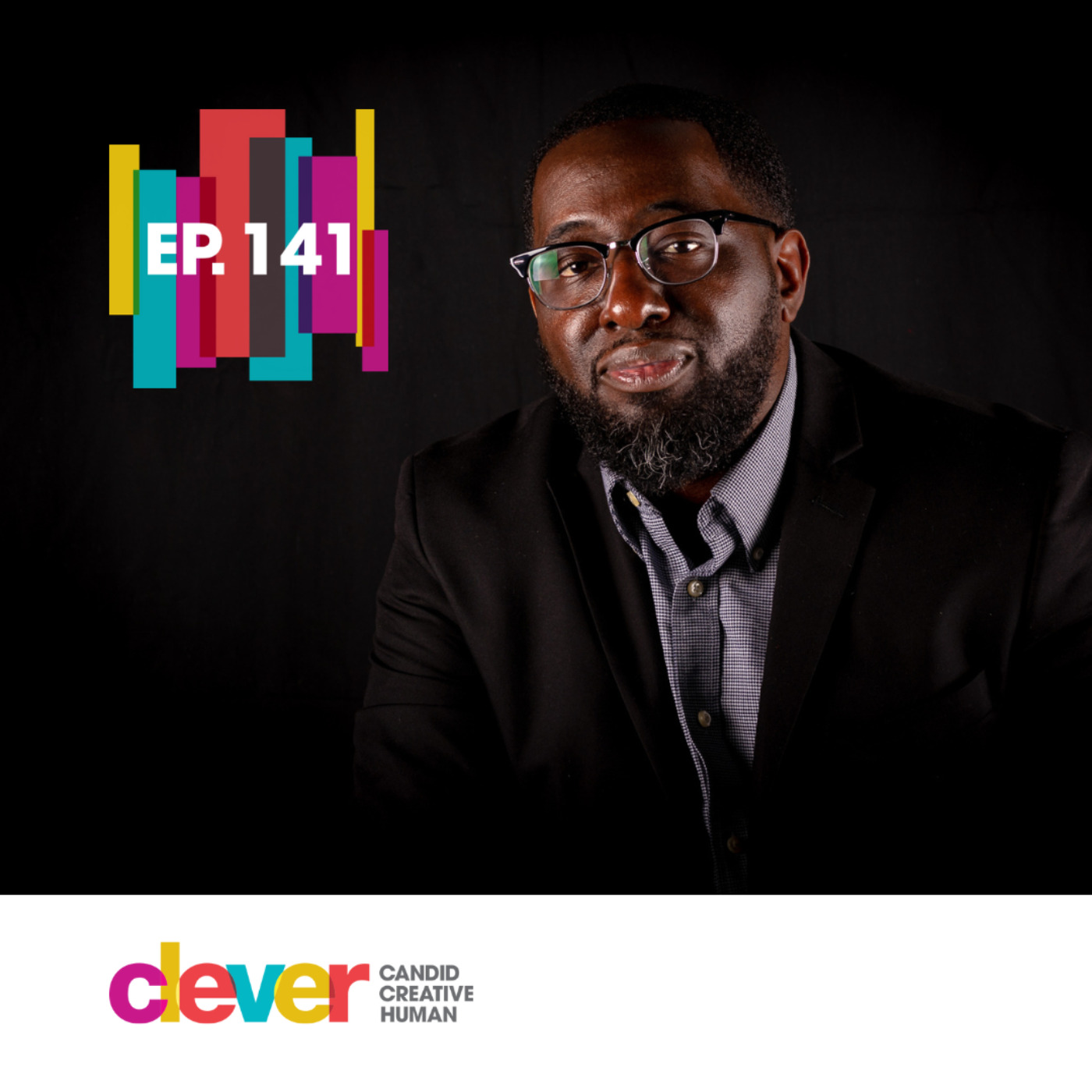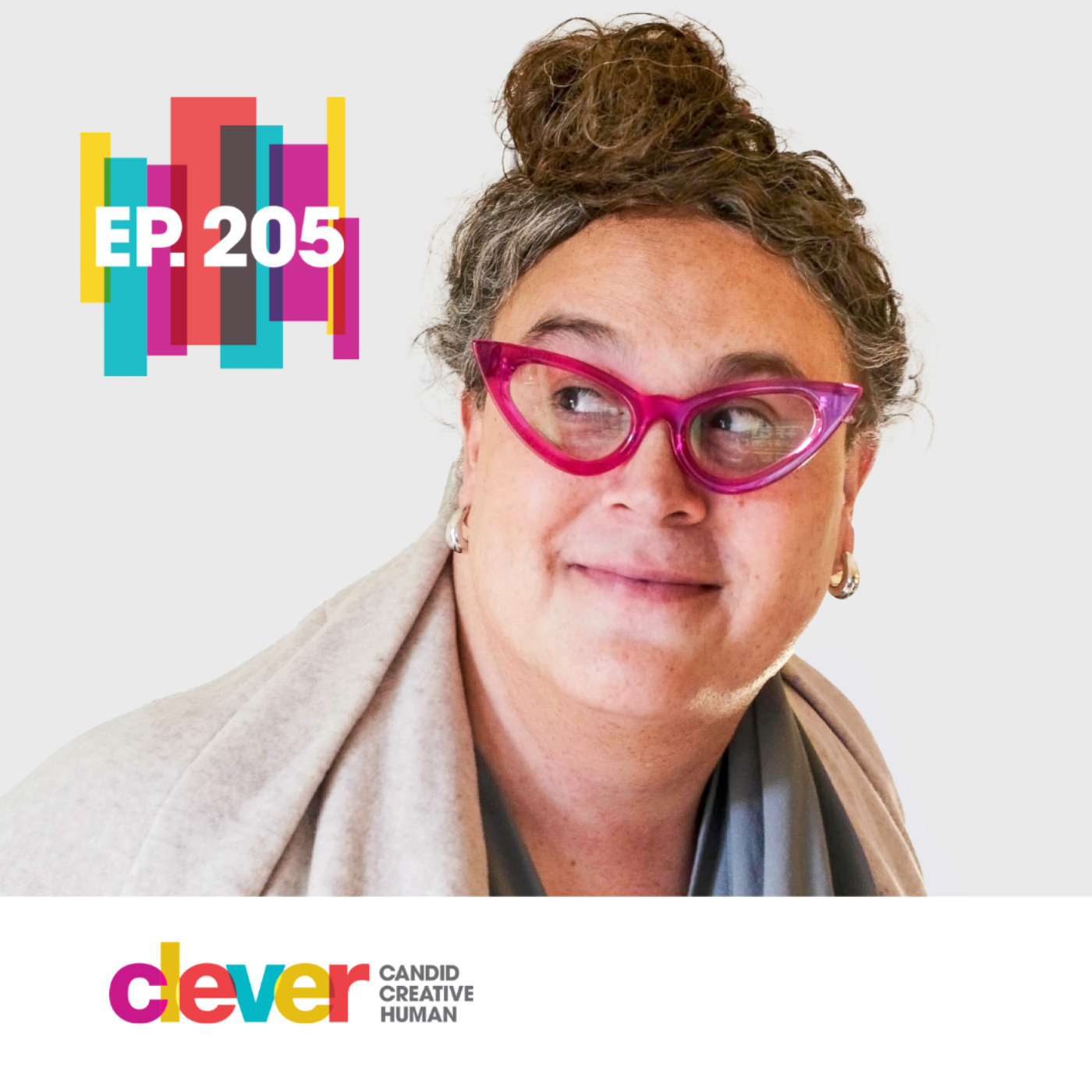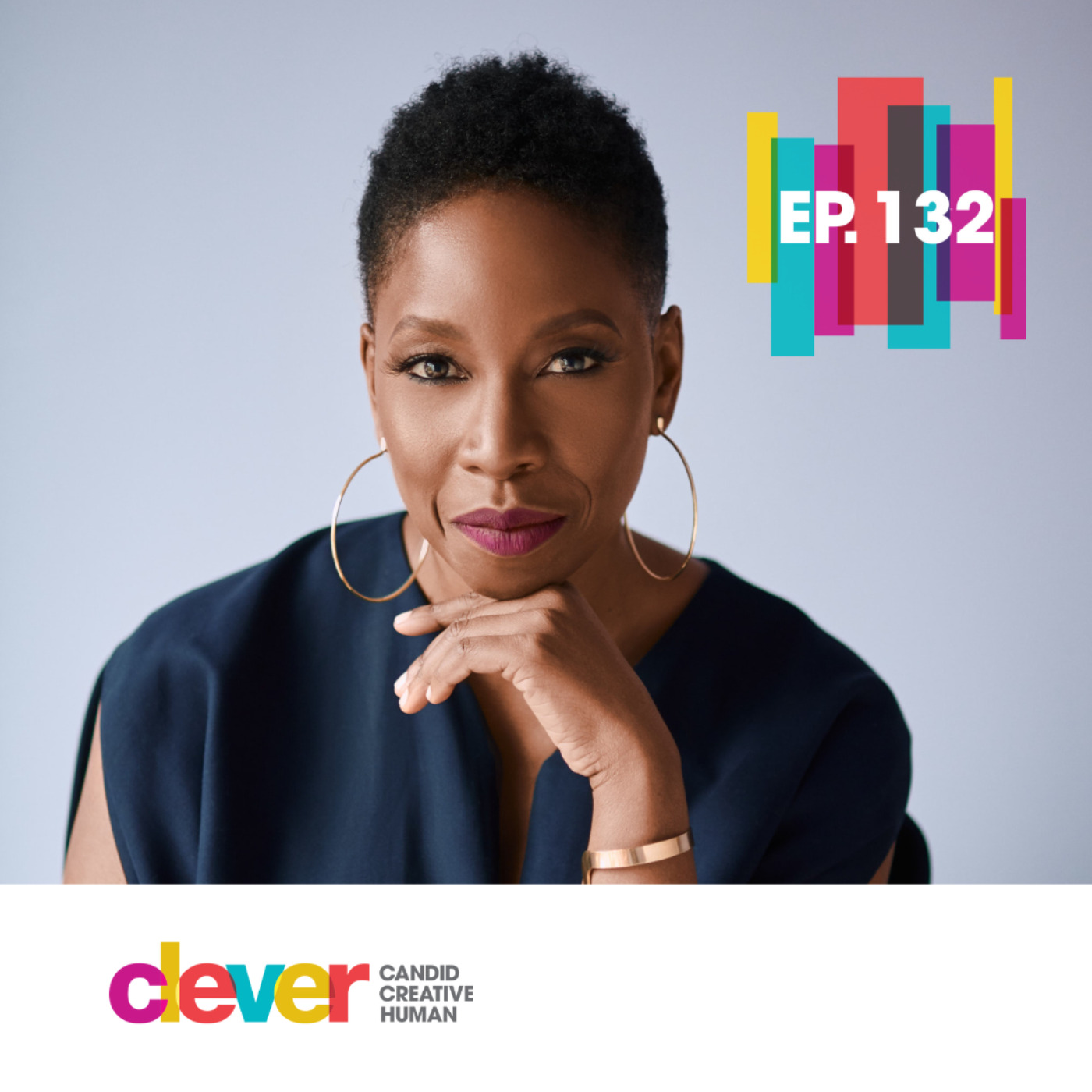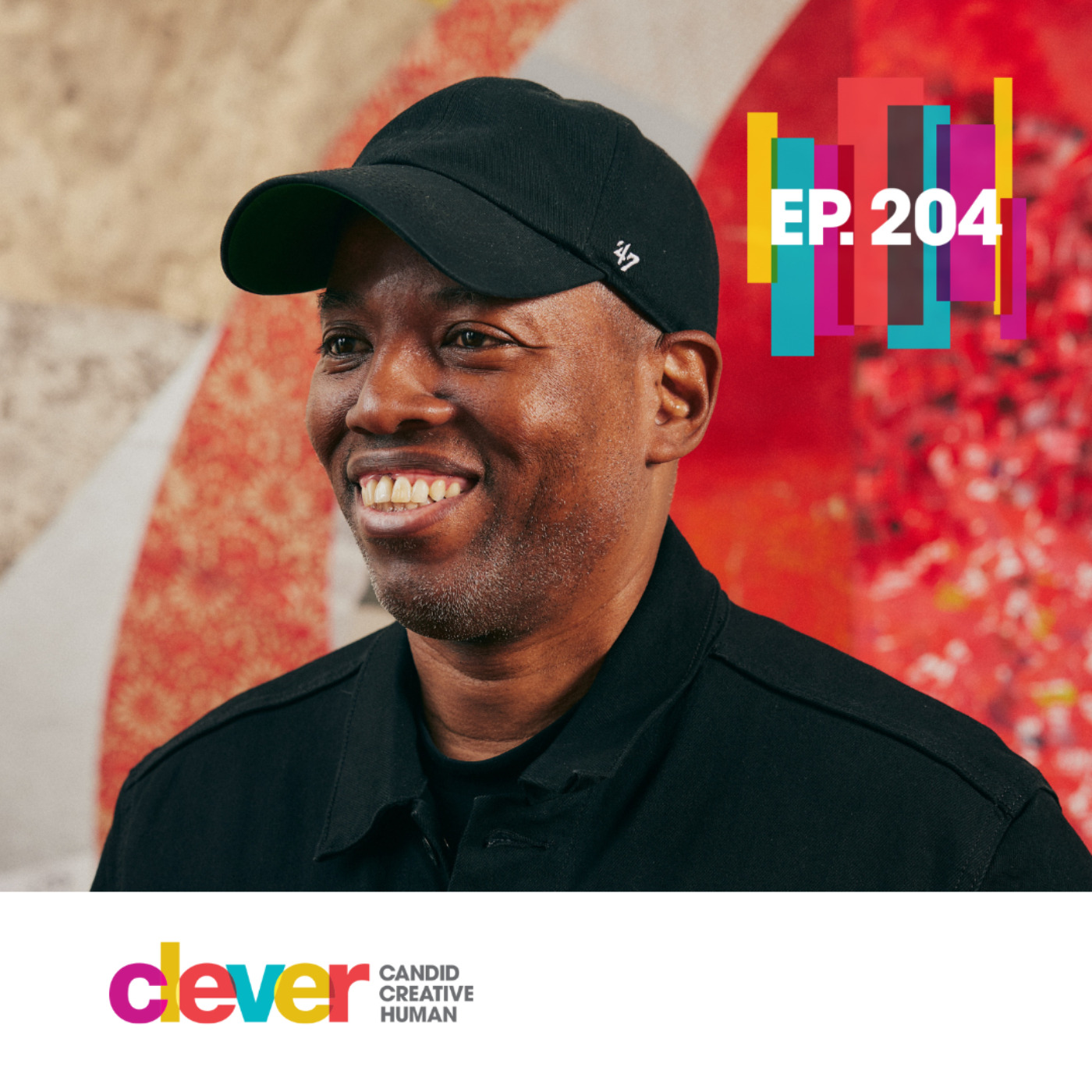Interior Designer Kia Weatherspoon spent her youth making frequent trips to visit her brother in prison – a deeply dehumanizing experience that left a big impression. In the military, she was deployed shortly after 9/11 and awakened her innate designer in the need to create privacy and comfort. Now, Kia is delivering on a quest to ensure that interior design is accessible for all, especially those in economically challenged communities.
Please say Hi on social! Twitter, Instagram and Facebook – @CleverPodcast, @amydevers,
If you enjoy Clever we could use your support! Please consider leaving a review, making a donation, becoming a sponsor, or introducing us to your friends! We love and appreciate you!
Clever is hosted & produced by Amy Devers, with editing by Rich Stroffolino, production assistance from Ilana Nevins and Anouchka Stephan, and music by El Ten Eleven.
Kia Weatherspoon: We are actually in service of the people and the communities that we create. And I think we forget that. We forget that in the trial of deliverables and all the other things.
Amy Devers: Hi everyone, I’m Amy Devers and this is Clever. Today I’m talking to Interior Designer, Kia Weatherspoon. Kia is a force of nature and has spent the last 15 years defying every design stereotype. She’s specifically challenging the notion that interior designed spaces are a luxury, reserved for only a select few, rather than something that should be regarded as a standard necessity for all. She founded her studio, Determined by Design, over 10 years ago based on her practice of Design Equity, as has since become the go-to for interior design in economically challenged communities. The ripple effect of her work is prompting housing developers, agencies, and industry partners in these communities to take notice and to do better. As an advocate and educator in business leadership, equity, and diversity, Kia has been recognized as a HIP Designer for Good by Interior Design Magazine, a part of the Washington Business Journal’s 40 under 40 Class, she received the International Interior Design Association Luna Textile/Anna Hernandez Visionary Award. And was recently named 2022 Designer of the Year by ICFF Interiors. As you’ll hear, Prior to becoming a designer, Kia served in the military – a foundational experience that has impacted her deeply and informed her design philosophy. Kia is leading a meaningful charge in the name of Design Equity and in doing so is elevating the entire field to a higher vibration – here’s Kia…
Kia Weatherspoon: My name is Kia Weatherspoon, I am in denial, but I live in Atlanta, Georgia where I teach full time as a professor at SCAD and I also run my business, Determined by Design, remotely. I feel like every person should feel seen and acknowledged and value through the spaces that they traverse through. And I know I do it because I didn’t have that and I don’t want that for other people.
Amy: I can’t think of a purer reason for doing what you’re doing than identifying a need that went unmet in your life and now you’re making sure that it doesn’t go unmet in others. More power to you. Let’s go back to that childhood. Can you paint a picture for me?
Kia: I grew up in Portsmouth, Virginia. My mom was a teacher, she’s a die-hard educator. My dad was an electrician/alcoholic/drug addict. I grew up with my brother, Cody, and we were a tight-knit little family of four. I was always very talkative, very outgoing. Recently I was purging some report cards and I found one from the second or third grade. It was like: Kia is a great student, but she’s very talkative. I’m like, today that works in my favor (laughter)…
Amy: Yes!
Kia: But I think a big thing that defined my family’s life was my dad was in and out of rehab and jail and then when I was in middle school going into high school, my brother was incarcerated for 15 years. And Virginia is a Commonwealth state in the South and he was a first time offender and he got over-sentenced, and he got 15 years in prison. Once that happened… there are no rosy pictures of me in Portsmouth, Virginia?
Amy: Yeah, I’m not surprised you don’t have vivid memories.
Kia: I try to think about them and when I can say, I can tell you nothing about the childhood home I grew up in, I do have pictures of this hideous pink and white/cream wall covering and I’m in this hot pink flex suit with all this sass. But that’s all I have for you, seriously, about the home I grew up in. I think I always knew I was bigger than Portsmouth, Virginia and I never felt grounded there. And in very pivotal moments of my life I didn’t feel seen by my mom, my dad or my brother and I was always starved for attention.
Amy: Can I ask you if you didn’t feel seen because you didn’t feel understood or were they just completely involved in their own issues
Kia: I didn’t feel seen because my brother always needed everything. And I remember when he was incarcerated, again, my mom is a teacher, my dad had a job where he was either in jail or in rehab, so we didn’t really have really good financial resources. Everything became about Cody, like everything became about what Cody needed, Cody was going through the penal system, Cody was on trial, Cody-Cody-Cody-Cody-Cody-Cody-Cody-Cody-Cody-Cody! And then I went, anybody? Anybody here? No? Oh, okay.
And look, I can laugh about it now and it’s not to diminish this experience, but I think I’ve learned to stop letting it define me. And life doesn’t happen to you, it happens for you, and all the things, and who I am now is because of that. And don’t get me wrong, me and my family are like super, still super close…
Amy: You are exuding resilience just in everything that you’re saying. This is not a pity party, but I’m really grateful that you’re being so candid. Growing up when somebody else is pulling focus, and it’s also kind of worthwhile, you understand why the energy and attention went to Cody. And at the same time you’ve got to honor the formative impact it had on you.
Kia: Oh, absolutely I was only acknowledge in my family when I did something good or I was successful. I was like, oh, so if I do something successful, I’m acknowledged? Oh, then I became super, super fucking successful, right? Like I did a good thing. In school I was seen, I did this thing, I got an award, I was seen. So it became this narrative. Do the thing, then you’ll be seen. Get the award, then you’ll be seen and now I got all the awards honey! (Laughter)
Amy: I know! I was researching you; I was like, I can’t say all these in the intro, it will be like 20 minutes long! (Laughter)
Kia: But there was a point where I had to gut check, life how much validation do I really need from external things, an award, recognition, success. I really had to learn to validate and see myself in ways that no one else did. And I think it was my upbringing that forced me to do that in different ways. But also it made me who I am, like it made me hyper successful. Remember I said I can’t tell you about my childhood home, but I can tell you about the first prison I visited. Such a visceral reaction for me, and that was the first time I walked in a space and I just knew I didn’t belong there, no one else belonged there. It was the first time I thought about space and how space affected other people in a very visceral way.
Amy: Can I ask you to unpack that a little bit? I’ve never physically been in a prison. I’ve seen them on TV and I don’t know how realistic that is, but I can understand that they’re, for the most part, designed to cage people not to rehabilitate them, not to comfort them and I think there’s inherent flaws in that methodology because… for so many reasons. But can you describe just how undignified the whole experience was?
Kia: The first thing is, depending on where your loved one is, you drive sometimes eight to 12 hours. You stay at a crappy Comfort Inn in the middle of nowhere. This was right in between Tennessee and West Virginia. And you pull up into this parking garage and the first thing… you have to think about the scale. I think I was 14, maybe 5’2 and you first walk into just bars and these loud clanks of…a lock, literally like this lock shutting. And you’re kind of walking in, you’re like, I’m going to get back out, right? It’s so intimidating and just absolute… and I’m just entering the building now. So you enter in, you hear this thing kind of like shut you down from an auditory perspective. And it’s gray and drab and not dirty in the sense of dirt, but it’s just gloomy and you’re like, okay, there’s no seating, there are no chairs the family you’re with can be in there. And then you’re in that drab space.
And then you walk in and someone is looking at you through a plate glass window. You say who you’re here to see and I’m separated between bars, concrete, plated glass and then there’s like a door, after they check all the things that you can then now go through, and then you get searched. When it’s on TV, it’s actual lies. The perspective from that of a 13 year old girl, I just remember feeling scared and uncertain. You go through the doors, you get searched and then you go into these visitation rooms and all you see is tinder block that’s painted yellow, because that’s a happy color. (Laughter) And then there are these artistic murals of a seascape or a jungle that typically the inmates would paint and then there would be dark wood round tables and plastic burgundy chairs. Fluorescent light, no windows, and my brother, he moved through three different prisons when he was incarcerated for 15 years and they were all some version of that. I remember, I used to get so angry with him. Because we’d have to drive eight hours, every visit I was angry with him. I approached every prison with anger.
Amy: You approached these visits with anger, so as someone who hasn’t had the opportunity to emotionally mature yet, you’re only 13, that’s a natural response. But at a time when the family is fractured, like anything to make the visiting experience more kind and compassionate, seems like it would do wonders for everyone involved.
Kia: Oh absolutely! At 13 I was angry, then it went from how I felt to just, you look around the room and my brother, he didn’t have any kids at the time, but you look around the room and you would see kids playing with their father or their grandfather. And I was starting to think like, oh man, that sucks for them. You would see babies, you would see grandparents visiting their grandsons, you would see women visiting their spouses, you would see parents visiting their sons… and sometimes the age range, right? Ethnicity didn’t really range that much (laughs) and as I got older I was just like, yo! this is no place for anyone to be with their loved one.
And then I even started looking at, I wouldn’t want to work in a place like this eight to 12 hours a day. And I started thinking about the experience for the guards. I had a very long time and a lot of visitation to think about how undignified, inhumane it was for everyone who interacted with that space. And you drive off, or you drive up and you could hear the guys banging on the windows, saying hey, hi, not even necessarily to their family member, but just to see people, right? And sometimes if your friend knew you had a visit, they’d be like, “Hey, that’s Spoons sister, hey Spoons sister.” And you’d hear these men in these teeny-tiny windows just clambering for connection to outside. And maybe they didn’t get visitors, right? That’s how you left.
Amy: What an impactful experience and I think it’s quite telling that you remember the prison so much better than you remember your childhood home.
Kia: Yeah, exactly, exactly!
Amy: You kind of painted a picture of a teenage angst that involved hyper achievement coupled with anger and prison visits.
Kia: Yeah, absolutely.
Amy: So that drive, which was a coping response in your teenage years, clearly you still have some of it, but you’ve adjusted it, so it’s not maladaptive anymore.
Kia: I leaned into my personality and my self very early on, from a place of wanting to be seen, attention… I knew very early on; I could talk myself out of anything. I was kind of mediocre academically and this was a very pivotal moment for me, when I was in high school I had got expelled from high school my sophomore year, going into my junior year because I had brought a razorblade to school. It sounds like, oh no, but why I brought the razorblade is quite comical. My mom had showed me how to get lint balls off of my polyester pants, from 5-7-9 and I had to use a straight razor. (Laughter)
So I took the straight razor to school to get the lint balls off my polyester pants from this cheap fashion store. And someone told them I had a straight razor and whether I brought them there to get lint balls off my cheap pants or not, I brought a weapon to school and I got expelled and it was like four weeks left in the school year. I was like, you know what, this thing happened, it was my own fault, whatever, I’m still going to graduate with my class on time. I refuse not to graduate with my class. So after that I would take extra classes every summer, every semester after that and then I graduated on time with my class. Now, my mom is telling this story to a room full of her colleagues and friends when she’s retiring from the Chesapeake public school system with 30 years of service. And I’m like, why is she telling everybody this hideous story? And she goes, that is the first time I knew that my daughter was ‘determined by design.’
Amy: Oh, that’s where the name comes from?
Kia: Ding-ding-ding (laughter). I was going to get you there girl, thank you for staying with me. (Laughter) In my accord, ‘There is nothing I cannot do if I do not set my mind to it. At my essence I am determined by design. Resilient, determined…’ but that was the first time in this thing where something I did silly, but wrong, but I would not let that hinder how I was going to progress or move forward. I was also into dance, ballet, quite a bit. That was kind of my outlet. I initially wanted to go to college for dance and I didn’t have the grades. So I went to a junior college in Petersburg, Virginia. And then when I couldn’t quite afford that, I went into the military and I joined the air force in 2001.
Amy: Yeah, I read about that and you were deployed shortly after 9/11, yes?
Kia: Yeah, that was my first duty station in Wichita, Kansas, and that was in July of 2001 and then September 11th happened and I was on the first of five deployments to the Middle East. And I was at Al Udeid air base in Doha, Qatar, it was a bare base. I was in a tent with about 14 other women and I needed some privacy, I needed to cry and I was a prideful little 19 year old and I wasn’t going to cry in front of these women. It as my first time out of the country, my first time away from my family. I took some sheets, I hung them from the top of my tent and I made three sheet walls around my cot and that was the first space I ever created. And I balled like a baby for 15 minutes.
And it was something about how that space, it healed me and brought me comfort and it brought me solace and I would do that four more times over the course of my military career on active duty. And hands down, the military was one of the best things I ever did.
Amy: I want to talk more about that, but before we move on from that really formative experience where you made yourself some privacy with the sheets, there’s something that really stands out to me about that. There’s something really, really great about the way you took matters into your own hands so that you could care for yourself.
Kia: Oh yeah, I was like look, if I’m gonna do this, I’ve got to let these tears out real quick! (Laughter)
Amy: That is so powerful, honestly.
Kia: Yeah. I needed it. I needed it.
Amy: Oh, I’m a crier, so I know how badly it’s needed.
Kia: Oh yeah, I mean it was the only emotion I knew (laughs) in that extreme.
Amy: Yeah, and you’re in an extreme circumstance.
Kia: Yeah.
Amy: Okay, so you said the military was the best thing you did. Let’s hear about it?
Kia: So it’s at the height of the war, it’s at the height of the war, September 11th just happened and it was one of the few times, you just saw people come together for something bigger than themselves, right? And again, I’m 19, so you know, I remember we being like a little tent, little tent area and there’d be like games and pool tables and stuff and I would hear people say, “I just had to do something,” and this was it. They joined out of sheer, just desire to serve their country and do something bigger than themselves. It was not about politics. I had never been around anything like that. People were wanting to serve at the most basic level, through joining the military.
Amy: And putting themselves in great peril and discomfort to do so…
Kia: Absolutely.
Amy: Yeah, I can feel your collective camaraderie swelling right now.
Kia: Yeah. I remember one time, you know, so I remember we would do like three on, three off, right? And we would do shift work and I remember I was working with this guy, and we were trying to figure out which music we were going to listen to and he was like, I don’t really listen to rap music. He’s like, I’ve never been around a black person before, so we don’t listen to that type of music. And I was like, for real? And he was like yeah!
And then we just had this whole dialogue, right? At the end of the day it didn’t matter whose music we listened to, we just learned a little bit more about each other and we learned about tolerance, right? Because we’re there for something bigger than ourselves. Not, well I want to listen to my music and you want to listen to your music.
Amy: Right, it’s not a situation like college where you’re scanning and choosing your friends based on similar things that you like or your interests. It’s more like our bigger interest is serving the country. What are our little differences, because that’s going to make this interesting, right? If we can get to know each other.
Kia: Yeah and I think it’s just like, it doesn’t matter guys. And I think sometimes we forget things are bigger than ourselves. I think we forget all of what we learn and I think that to me, you know, it taught me how to respect the person, not their title, right? You could have rank in the military, but attitude reflects leadership. And if everybody in the office or on the ship is talking trash, they’ve got bad energy, that’s a direct reflection of leadership. It’s not about your title, it’s not about your rank, it’s how you treat people and how you respect people.
And it also taught me how to speak respectfully and as long as I’m respectful and I put ‘sir’ or ‘ma’am’ on the end of it, I could say anything I want. Those are the things that I got from the military that are invaluable. Oh! Oh! I would do it again the exact same way every single time.
Amy: Do you still have friends in the military? Are you still connected?
Kia: I did four total years on active duty and then I did another 17 years in between the guard and the reserve. So I did a total of 21 years of military service. I have a lot of great, great friends. The nostalgia of it wore off around year 10 (laughter)…again, it’s so funny, my military career was book end by two extremes and I think you know, sometimes we stay in a thing because we think we should. But the minute you can’t show up with 100% integrity, giving 100%, it is time to walk away. The minute you just hang around and do… you pussyfoot and do the bare minimum because, you know, I can…there’s a reason and you shouldn’t be there. And I talk about the start of my military career, everybody is doing something bigger than themselves and then I book end my military career in June of 2020, George Floyd was just murdered, I’m living in DC, it’s a racial uprising happening.
They activate the national guard. They put me in riot gear and a helmet and a shield and I’m just like, I’m HR guys, why am I out in these streets? But I’m also a black woman in the nation’s capital as people are protesting.
Amy: Oh fuck!
Kia: Everything in my being is like… I can’t do this. Contractually, I had to, and again like I said, there were years leading up to this, it’s time for me to retire, it’s time for me to retire. But this was the first time I was really conflicted because I knew this was no place for me to be. I was in a white man’s military. I just couldn’t do it.
Amy: I hear you, and the story that you told communicated to me… like my body is short-circuiting right now trying to imagine the conflict that you must have felt.
Kia: Yeah, but this is also, goes back to the things the military instills in you, which is why I have such a love for it. It teaches you to be a good wingman. So the racial uprising happens, they activate the DC Guard. Now technically my job is HR at this point. So HR, we’re supposed to know where all the people are, right? So we go to the base and everyone is clambering, they’re getting gear and one of my coworkers somehow… they were like, raise your hand if you have your gear, blah-blah-blah. Now, she raises her hand, the rest of them are kind of like, oh, I don’t have mine. And they’re like, Wilson come with us. And I’m like, oh, but she doesn’t have a wingman. And I’m like, well I’m not going to let Sergeant Wilson not have a wingman from our shop, our office.
So I go with Sergeant Wilson, because she needed a wingman. And then she and I were the only people from our shop who were directly on the street, in the riot gear. Everyone else quasi got out of it, but because you always have to be a good wingman, she and I were in those streets for 12 and 18 hour days at the height of all that madness going on. She and I both felt like, as two black women, why are we out here?I still cannot not be a good wingman in that moment. What I could have did was just like everybody else and go, no, I ain’t got mine either. It taught me that, it was bigger than myself and it was about being a good wing woman.
Amy: You can’t let her go out there on her own.
Kia: Yeah, you got to be a good wingman, it’s just… it’s culture. I wouldn’t have gotten these life lessons any other way. Hands down one of the best things I ever did, hands down,
Amy: I love the way you tell them, it’s inspiring, as gripping as it is, it’s also really inspiring and yeah, I see your conflict and I’m glad you got out of there when you did…
Kia: Yeah, me too. Me too. And I will say this, so it’s like, all right, how did you become an interior designer? When I had got out of the active duty military in 2004 and I had just… and the war was supposedly over, but I remember just being like… I enjoy creating those spaces. I want to do that, what’s that called? And that’s how I became an interior designer.
Amy: So many people stumble into design, they don’t even know it’s a profession, but somehow it impacts their life and they ask somebody, what’s that called and they’re led to design and that’s beautiful. I want to hear about your undergraduate experience because I’d also really love to hear about your thesis work.
Kia: I left the military, I went and got an associate’s degree and I worked briefly at a hotel management company. That was my first quasi design job, and the first time I realized the things that really matter are work ethic and selling, right? I was able to upsell my interest in design at this point to a position as a design coordinator. Back then you couldn’t work fulltime and get a design degree at night. And I learned another valuable lesson. I’m not motivated by money.
And I remember when I decided to get my bachelor’s degree, I had a plan, told it to my CEO, he was a perfect type of first CEO out of military, he was rich, white and sexist. And I remember him looking down my shirt, and I’m not a busty woman, and him being like… I just gave you all this money, you can either work here, or you could go back to school, but you can’t do both. And I knew right then, I was going back to school fulltime and no man could or could not tell me how I could dictate the path of my career. That was a perfect lesson for me in that moment.
And I stumbled across a college/art gallery, called Moore College of Art and Design, it’s in Philadelphia. And I remember just seeing the gallery spaces and it was all these amazing artists and artisans and makers and that, and I was like, oh my god, this is a school? Can I get in here? And I did. And then the first day of class, I’m all excited, I’m an older student, and I’m looking around and I’m like, there aren’t any men in here. There are no boys. And it was an all-women’s college (laughter).
Amy: Oh!
Kia: And I was just like, okay, okay, and when I say it was the, I’m going to get emotional talking about, it was the best thing I could have ever experienced. I had never been in a more supportive, encouraging environment ever in my life, than being at this small women’s college in the center of Philadelphia. It was glorious.
Amy: It sounds like a garden oasis in the middle of (laughs)…
Kia: It literally is.
Amy: Brutal patriarchy. (Laughs)
Kia: Yeah, it was just talent on talent and I remember… I never saw myself as an artist, I saw myself as a creative and a designer and I remember, it was like my third year there. And when I say I was with these young women who I swear they came out of the womb creating. And my third year, this girl named Brenda Matthews, she looks over at my work and she goes, “Kia, did you make that?” I was like, yeah. She was like, “You’ve gotten so much better.” I was like, I know, right? (Laughter) It was just like… boosted my confidence, it was always just so lovely. They poured it into me in a way that no one else really had. And my undergraduate thesis, full circle moment is, all my classmates wanted to do hotels, one girl was doing a cruise ship for Disney, a beauty retail space and I was like, actually I want to do a prison facility for 75 men and that was my undergraduate thesis. And everyone was like, a prison? I was like, yeah. And that was what I did. I wanted to pay homage to my brother through this new creative career path that I was on.
Amy: And were you able to reimagine a space of incarceration that was also like…
Kia: Absolutely, I remember the way I’d space planned it, the concept was a part of like Newton’s Law, like an object in motion, that an object stays at rest until something pushes it forward. So this facility was all about rehabilitation and forward motion. And even the way I’d space planned it, no one ever moved in a backwards motion or went in a circle because when you think about circularity in the prison system, it really translates to recidivism. So I didn’t want these men to move in a backwards motion. They always moved in a forward motion. The way the kids came into the space, there were these soft lounge and seating. There was this huge natural skylight, there was soft seating in the common area, in the men’s rooms. I did this custom Korean desk/bed combination with these curved soft edges in the actual cells. And this soft blue, navy color… we had carpet tile, because my rationale was, if I put them in a soft chair, but they’re still separated from society, what is the punishment, right?
Amy: Right.
Kia: If you put people in a box, how do you… a caged box, how do you think they will come out?
Amy: The punishment is imprisonment, but we don’t have to dehumanize them while they’re in there.
Kia: Yes, yes! Absolutely! Absolutely! And I think we forget that people who commit crimes, they commit crimes because of mental health, home environment, lack of education and lack of opportunity. I had so much pushback in my critique, well, what if it was a murderer, what if it was this. And you know, 60% of people who recidivate are non-violent offenders. It’s not the murderer who was in jail for 20 plus some years. So it was really about humanizing people and wanting to rehabilitate them and the prison that I designed became the thing that pushed them in a forward motion out into society. It was a really good project, really…
Amy: I mean it sounds like you’re very clearly identifying your goals, your values, why you’re in this, what the power of design can be. And like now you have to go and get a job and work, you’ve already been harassed by a rich, sexist short looker downer…So you probably are like, that’s not for me. So what are your first few steps into the professional world as you are charting your own course?
Kia: Well now, now, our industry, what is a sexy thing to do? Everybody wants to do hospitality. Hospitality and boutique hotels, it’s sexy, it’s glamorous, it’s all the things, that’s what I wanted to do. I first went down the path of still staying in the hospitality space. I did a brief stint in high end residential design, as an intern. And then I met this woman on like a shadow day and she was like, I like people, but I don’t want to work with them. And then she told me all about multifamily design (laughter). And she was like, we don’t work with individual home owners, but we get to create homes for multiple people. And that’s how I transitioned from hospitality to multifamily design.
Amy: So multifamily design, you’re working with a developer, you’re not working with the owners of the home who are known to be quite involved…
Kia: Yes, yes (laughs). So I have fallen into doing multifamily design and then I immediately started doing high end luxury multifamily design in the DC area. And I’m working at this great firm and again, our industry is notorious for this, I was working late hours, pulling all-nighters. In college it’s cute, at 31 it was not. And I remember, it was my first big design project, I was up all night, went home, took a 30 minute nap on the floor – don’t ask me why, I had a bed – I showered (laughs) and then I went and presented to the client. And did a great job and then we went back to the office.
My boss didn’t say like, take a comp day, leave early, nothing. We just kept going. And that wasn’t a good feeling for me. And two weeks later, we’re sitting in this meeting and she’s like, Kia, you don’t seem like you’re here. I think I always know when it’s time to move. Again, like I said, when I can’t show up as my whole self and give 100%, I got to go. And that’s okay. So I gave my two weeks’ notice and I was like, okay, what are you going to do now?
Amy: Oh man, you gave notice without a plan?
Kia: Yeah girl! (Laughter)
Amy: You’re so bad-ass!
Kia: Or ignorant! (Laughter) One or the other. Two things happened. I was like all right, I can go get a job at another firm. I was like, well I want to go work somewhere where they have leadership that looks like me. This is 2012 now…I said, you know what, I’m going to start my own business, just like that, just like that. I said I’m going to start my own business and I have this comical video of me sitting in my car, in the parking lot, outside my job, like I just quit my job, I don’t have no money, I don’t know where my next rent check is coming from (laughs). But I started my business, that day I quit and I decided to start a business in 2012. And I knew immediately it was going to be called Determined by Design and that was it.
Amy: Granularly, what did that mean? Did you just go home and open a laptop and that’s your business?
Kia: Okay, all right, I’m going to do this business, what do I need to start a business? So I had a little Google search, because you take professional practice in college…
Amy: Yes you do! (Laughs)
Kia: But it didn’t talk about this part. So then I used the Interwebs and figured out all the steps that I needed to take and how many of those steps I could take that required no money and could get free resources from the city. And then when the resource wasn’t free, I would sometimes not pay my student loan bill for the month to pay the $600 to do my LLC application.
Amy: Okay, so prioritizing and getting scrappy with your resources and stretching. Did you have collaborators?
Kia: Just me.
Amy: Your fortitude is impressive!
Kia: In the military they tell you this thing, no one is going to want more for your career than you. No one is going to be a better advocate for you than you. And I say all the time, I am my own hero. And as a woman, right, you win the awards and you’re supposed to say, oh, I’m so humbled. And then they ask the question, “Who was your mentor?” Me! Me motherfucker, it was me!!! (Laughter) And I say that because this is where those childhood triggers would come into play. I remember early on in my career, when I started my business, because I knew nothing, you know, and I’m reaching out to people, hey, you’re fancy in industry, or industry adjacent, can I meet with you for coffee? I just want to learn your story. Oh honey, when I say they would not respond to me, and I’m pretty persistent, I would email them five and six and seven times, not asking them for a job, just wanting to… like that same little girl, who is wanting some acknowledgement and I heard nothing from them, nothing. No response.
Now this is when I get a little petty and I worked through it with my therapist. Years later one of those women reached out to me on LinkedIn and was like, oh my god, I heard about you, we should connect. I was like, actually we should not because back in 2012 bitch, you ignored me! (Laughter) But it was just me, and it was me who figured it out, every step of the way. And in all seriousness, so I don’t have no job, so I need some money, so the first thing I did was like how do you get a client? This woman reached out to me about doing a non-profit project for this organization called Room to Rebloom. And they created healing home environments for domestic violence survivors. They were a new non-profit organization and they were doing transitional housing, again, multifamily, right? Multiple units, corridors, common areas and I said, oh my god, I will provide pro bono design services. I have a new business with no clients and no money, but let me do free work. (Laughs)
Amy: Oh, but I can see why you couldn’t say no because this is already right up your alley in terms of creating healing spaces.
Kia: The universe will show you exactly what you need, you got to be patient. So I go to the building, it’s 12 women, 32 kids, I’m like over-excited. [0.50.00] And then first of all, girl calm down, and then they say to me, look, we don’t need interior design services, that’s not what we need right here. And there was this gut check moment where one, I calmed down, and two, it was a moment to just realize, I’ve been there. I’ve been there where I didn’t realize how much my space could impact and change my life. Yes, you don’t know what you don’t know. And it ended up going from don’t we need this to us, or me engaging with them in the design process and not for them. That’s a very clear designation I’d like to make. I designed with them. And one of the things that I loved was that none of these women could tell me what they needed, but they could always tell me what the other women needed, she has teenagers, so she needs this… she has a newborn, so she needs this. And that was just really powerful how collectively they knew what their neighbors needs were.
Amy: Because collectively we’re socialized to look out for other people’s needs and to deny our own.
Kia: Yeah, yeah, and it went from we don’t need this to man, I thought this was stuff I could only see on TV and then this is the kicker for me, is there were two moments. One woman was like, is this something I could do one day? I was like, yeah, you can! And sometimes with our industry, it’s all about the big, glossy reveal and the pretty picture. And we had that. We had those moments and when we did the reveal, this woman came up to me and she said, “Miss Kia, when I walked into this room, I realized change was possible for me.”
Amy: Oh my god Kia!!
Kia: I know. I know. And I felt it in my soul. And right then I knew the people who need access to well-designed spaces the most, they don’t know they don’t have it, they don’t know they need it and they don’t have an advocate. And I built my entire business around being that advocate. And that’s how I knew what the mission of Determined by Design was going to be. I knew right then the work that I was going to do, it was 12 women and 32 kids and they all looked like me. They could be my sisters, my cousins, right, my aunts, my nephews, my nieces, my people needed access to elevated spaces. And this is what I tell people all the time about starting a business, and remember when I said that not being motivated money part. Had I operated from a place that scares me, oh, you start a business, I need money, I need money, I need money, I need money. I wouldn’t have taken that non-profit project, right? Sometimes you have to assess what is the bigger opportunity and sometimes that is not necessarily associated with a dollar value. Because that statement that woman made to me, I could never have quantified it to a billable hour. It had to be about the work, not the money. And that’s what we do at Determined by Design, we do the work. We do the work of the people and I still make a lot of money though (laughter).
Amy: Good, you deserve comfort and security and also freedom.
Kia: Yeah, yeah, but what Determined by Design does is we focus on design equity and that is creating elevated spaces for people, black, brown and indigenous people in economically challenged communities and that is what we do. We do affordable, transitional, supportive, senior housing. That’s what we do, we design for the people.
Amy: And in the last 10 years, you’ve racked up over 2,700 underrepresented families are living in design equity spaces?
Kia: Wait, wait, wait, we just did a little data dump over the holiday break. It’s actually 4,000.
Amy: Four thousand??!! (Laughs) Hot damn!
Kia: I was just like oh man, we did that! And you’ve racked up a lot of industry awards and accolades along the way, does that make you feel seen, a little bit, finally?
Kia: No, because when the awards came, right, I had, time and years of just doing the work, so I earned the awards. I didn’t need to be validated by them at this point. But the awards were secondary. When I say I remember we had bid a project called departments, 25 units, 10 of them were from chronically homeless people and I remember this man, he was like, you know, I never thought I could live with a space like this. We did a project in Baltimore, we’re bringing in the furniture, it’s this beautiful Kellex sofa with this nice cream arcane fabric and we’re bringing in the furniture. And they’re like, is this furniture staying here? Is this furniture for us?
Those are the awards. It’s Capital Vista, we have this beautiful picture of the Kadir Nelson print in the common area with this little girl called Sweet Liberty, a young black boy in a superman cape in the elevator lobby and the rewards are people seeing that they deserve something elevated. And I’ll be very, very clear that I’m not saying it looks luxury, it’s elevated. Luxury is an illusion, but when the people walk through these spaces, when the housing developer says, “Wow Kia, you and your team made this space look like a value in that the next three generations of people who will live in this affordable housing project know their worth, know they deserve something,” those are the rewards.
Amy: As you’re describing this to me and I’m sort of placing myself there, I’m feeling like your space are very affirming. I can imagine that someone, especially someone who thought that they never could live in a place like that, they’re walking down the halls and seeing black boys in superman capes and they’re seeing themselves reflected back in this considered… a space that’s considered them, that’s valued them in the creation of it. So it’s taking care into consideration, it’s taking their personalities into consideration…
Kia: Absolutely.
Amy: And it’s so affirming. It’s healing.
Kia: It’s healing, but here’s what makes us different as a firm. We don’t follow design trends, that’s not our jam, right?
Amy: That makes sense. Trends are disposable, right, that’s the opposite of affirming.
Kia: Absolutely, but trends every step of the way. Trends whitewash spaces and we at Determined by Design, we create spaces that reflect the history, culture and stories of the communities. And in order for us to do that, our design research for any project, it doesn’t start with the site, it starts with the land, right? What is the indigenous story that existed before the land was stolen and then bought, and bought again? We search for the narrative of communities and we bring it to the forefront. And then we look for the next demographic of people. The next heritage story, right? So we’re constantly trying [1.00.00] to bring in the cultural and ethnic narratives from the past into the present and we marry them together.
That’s how we make sure our spaces mirror the communities that they represent and the people who are in those communities. That’s what’s affirming, your history, your story, it is still relevant and we’re going to bring it to the forefront, not Pantone’s Color of the Year. (Laughs) It’s just not going to be that.
Amy: So this is beautiful and it’s also very, very, like you’re rooting it back into the earth, which is gorgeous. Can I get nerdy with you on your creative process for a little bit?
Kia: Yeah, absolutely.
Amy: Can you tell me what is the research like? How are you making sure you are reflecting the communities? You can learn history, but you still have to put it through a filter that understands the people.
Kia: Okay, so this is what our team does…We get a project, one as a firm leader, I give my team time to do the research. We’re not trying to rush through because of a deadline, right? We take a full 10 weeks in our schematic design process. The first two weeks of that alone is the deep dive, one team member will do the historical research. Another team member will do the community research, which is more present day and then a third team member… then they will do a context into the demographic of the neighborhood as it exists, right? So we bring together all this information. We always start with how did the community migrant… how did it migrate; how did it change?
Starting with a native story that then ended up maybe it went Croatian, then there was a Creole narrative, depending on where the project is, because we do work all over the US. We’re pulling all those threads. We’re pulling all those threads for all this context. And then we’re gravitating towards, now who were the makers? Oh… who was this famous person, what was he/she famous for? Oh, the first this was made here. Those are the things that we’re looking for. I’ll give you an example. So we’re working on this project in DC, it’s called Barry Farm, one of the largest public housing authorities in the district.
And it’s in Barry Farm, it’s called Hillsdale, it used to be a fishing village. DC is named for go-go music. The Junkyard Band, Earth and Kid, all these famous people came from these projects called Barry Farms. It was this centralized fishing village for native Americans. DC is known for Howard University and The Yard. Howard Schultz was one of the founding members of this housing development called Barry Farm.
So we’re kind of taking all these things and then our concept for the project became opening the senses to ascension. Because go-go music is this immersion of site, touch, sound, it’s full body. It’s in Hillsdale and we are slowly ascending this neighborhood. But then there’s also capturing the history of it. That’s how we get to our concept narratives. Not, we wanted to create the mid-century modern juxtaposition of the indoor/outdoor…
Amy: I love when you take it down (laughs)…
Kia: My team member, Sakoya, says, this is our prayer and our intention for the community, so it has to start from their history. And then we do a word play as a team and when we’re doing this word play, we’re throwing all the words out from our research words that gravitate to our soul. I think that’s what we do in a very kind of historical point of reference. But then also from a point of feeling, when our team members are coming up with our concept statements, it’s like, do you feel it?
And we do this, I say, close your eyes, close your eyes, now say it out loud. And the reason it’s important for you to feel it, because when that development partner pushes back, it’s that feeling. We fight for something when we feel it. So when we have development partners who make us make a decision that might be inequitable, I need them to fucking feel it, to challenge and to educate our development partners. So it has to start from a feeling, it has to start from a place of intention. It has to start from a place [1.05.00] of prayer, whatever that looks like. That’s how we do what we do when we create the spaces, we create.
Amy: You’ve just given the strongest explanation for how to know if your idea is truly worth advocating for. And if it is, you almost don’t have to… you don’t have to work so hard to convince people because it just vibrates from your very being, because you know so firmly in your soul that there’s a reason for this.
Kia: The key to business is this: People buy into people, right? So if every design decision we made is rooted, from the start, from inception, if the color story, the statement, if it is rooted in the history of people, you can always sell that. People will always buy into people. Our narrative is the people’s narrative and history. And other firms are rushing to get them to a deliverable, rushing to show precedent photos of other interiors to say how theirs can mimic this and another blonde wood swooped curve thing with a cream interior to mimic that.
That’s replicated. We’re about the people’s narrative, all the way down to our concept imagery. Our concept imagery is powerful, it’s impactful, it’s a major, it’s a fashion, it’s dynamic, it’s in your face. My team member, Sakoya?, she just presented a project and our concept was conjuring ripe heirlooms. It’s in my Miami, it’s in the Overtown neighborhood and we’re presenting this to the real estate developer. And the architects on the phone… one of the development members was like, I just moved to this neighborhood. And after her presentation, he goes, I knew none of this history about this town.
Amy: Wow!
Kia: And we’re educating them through design, concepts, color story, right? And this is relevant because when we come to projects, and I look at other affordable housing projects and they look like trash and they’re ugly, and I’m being real firm on that. And I think to myself, why is that? Because you don’t care enough, because that’s not your brother, your mother, your sister you have living in that building. You will do the [status folk 1:07:51] because you don’t see them as your people. That’s the problem. That’s why design is inequitable in low income communities. I need my counterparts to care and to do it from a place of feeling, like if ain’t good enough for my loved one, it ain’t good enough for this community either.
Amy: Absolutely, I felt like I needed to put an exclamation point on that, but I also wanted the powerfulness of it to just hang there. I mean that’s…
Kia: Yeah, they’re scared that we won’t get the next project, we won’t get the next billable hour. I had this architect say to me once, “How did you get them to make all those changes?” I told a better story than you! We can’t do that, we can’t bite the hand that feeds us. I bite it all the time and it keeps coming back. Because they see we are so impassioned and our industry has become so fearful of not getting the next project or the next fee, that they don’t push their clients. And the fact that they still call them ‘clients’ and not partners, you’re not trying to do something bigger than yourself, you’re just trying to get the next fuckin’ check. I need partners to change the way communities are built. We don’t say ‘clients’ at Determined by Design. We’ve got partners. And just like your partner in real life, if they do some fuck shit, you course correct them, you educate them. That’s why we say partners.
Amy: Yeah and it sounds like you’ve built a life for yourself that’s incredibly meaningful and also requires difficult conversations on the regular.
Kia: That’s okay.
Amy: Yeah. I mean just to double back to your design ethos for a second, that’s something that’s very, very … it’s powerful to me because this is something that I hold dear, is this concept of story stewardship. I mean it’s why I started this podcast; it’s why I built this platform to hold space for all of these different stories that need to be heard. I also teach design and I developed a class around narratives embedded in the built world. Because I think we need to all take those very seriously and as the future designers and architects of this world, we need to be really designing those narratives consciously and intentionally just like you’re saying. And I know that you’ve built education into part of your mission as well, not just in your day-to-day, talking with your partners and the people that you need to get on board, but absolutely… I mean but actually have developed workshops so that your design counterparts can do what you do instead of running in fear (laughs).
Kia: Absolutely!
Amy: Can you talk to me about that education piece for a second?
Kia: Literally I offer workshops to other firms, to community organizations, academic institutions, and I literally teach them how to do our concept development process, I teach them. The exact same way we do it in Determined by Design, I teach them how to do it, how to do the historical contextual research, beyond the site, engaging in the historical narrative. How to do the word play. Now I want you to imagine a room full of architects, let’s say it’s still the cliché kind of descriptor of an architect, 40 plus year old white man. And I’m asking them to close their eyes and feel the words (laughs).
And feel it! Feel it guys, feel it for me! But that’s what I take them through. I encourage them to tap into the feeling and the empathy that is inherently supposed to be embedded in every design discipline, architecture, landscape, lighting, right? There’s empathy that has to exist. So while I’m teaching them our step-by-step process, I’m also reminding them that we are actually in service of the people and the communities that we create. And I think we forget that. We forget that in the trial of deliverables and all the other things. But that’s what these workshops are.
Amy: I’m so happy to hear that that’s part of what you offer because I really like to see your philosophy scale and really percolate out through the whole design industry. I think we should all be designing from the perspective of caring and people first.
Kia: The biggest misconception is people are like… I say equity, affordable housing, low income communities and they go, oh my god, are you a non-profit? No bro, I’m a very profitable business! (Laughter) Like both don’t have to be mutually exclusive. I’m profitable because I lead with prioritizing the people I serve. I’m profitable because I lead with prioritizing my team members, and their wellbeing and their mental health. I’m profitable because I prioritize people. I’m profitable because I have a great relationship with my development partners. I push them. That is why I’m profitable. And we do great, beautiful, beautiful, beautiful work. Our work is beautiful because it’s rooted in the history of people, period.
Amy: I love it! I want to ask you some personal questions. I know w egot into your childhood and all of that. But now that you’re a profitable, grown woman with so many awards that we can’t list them all, and you’ve got 10 plus years of Determined by Design and 4,000 underrepresented families being served, so clearly you have enough to be proud of, right? Do you feel it? Do you let yourself feel really proud of yourself?
Kia: Recently yes.
Amy: Did you have to teach yourself to do that?
Kia: I had to really just realize, I don’t always have to keep chasing the next thing, what’s next, this, and it’s just like, just take a moment and be like, man, I did that, I did that. A C student from Portsmouth, Virginia built a million dollar business, that’s enough. That’s it. It took me, I would probably say the past year… the past two years and I love teaching and it took me, or the result of me going into academia full time, forced me to realize… it’s been very, very toxic for a lot of reasons. And that forced me to realize, actually I’ve done enough. I don’t have to do anything else. I will, but it has to feel good, but yeah, I’m very proud of what I’ve built and what I’ve accomplished. Let me tell you why I love that question, because… not my words, others, now I’m a design thought leader! (Laughs) And at the end of the day I’m just Kia, I’m human. I struggle with some of the same things that… I don’t want to be put on a pedestal because then everyone will be like, I want to be like… no, be like you. I’m successful because I show up as myself, that’s the success. I don’t have some heady design story of my grandmother was a designer and she did custom… no shame to anybody else’s story, but mine is a little bit more raw than that. Your story is enough for you to be your version of great. You don’t need to be like me. The world don’t need two Kia’s! Just you is enough, just you is enough. I don’t want to be this person on a pedestal. I’m approachable. I take calls from people because I remember when no one would take my calls. I am not special; I am just Kia. I got a beast of a work ethic and unwavering desire to make everybody feel seen. That’s about it.
Amy: That is enough. That’s enough because those are the most important things. Thank you for being so candid, for sharing so much and with so much spirit. I really love the way you’ve embodied… your design ethos comes through also in your delivery, in your embodied performance of what you do. You make us feel it. And you’re a very powerful storyteller in that way and when I say ‘storyteller,’ I don’t just mean your words, I mean the way you design and the way you hold space for story and honor story. And educate the importance of story. And so I just… I just have mad respect.
Kia: Thank you! Thank you, I appreciate that, I really do. We were talking about… we can’t have feelings in the workplace and whatever. But I think if we felt the things more, we will fight for others in a different type of way. It’s all right to get excited, it’s all right, to be loud… it’s okay because that means you’re feeling something, you’re excited about life and the thing that you’re doing. You don’t got to be all reserved. It’s just like, feel it, have fun, be passionate about it, be excited.
I can’t raise my voice… why? People get excited when other people get excited, and no shame to our industry, but all this stuffiness and the leaders and soft spoke… that’s bullshit, who are you? Who are you? People want to see who you are, I’m successful… people like me because they see me. There’s no airs, there’s no cut cards… colorful language at all, it is me. That’s the secret to success is ABC after school special at it is, show up as you y’all and have fun and feel it, please feel it.
Amy: I just can’t thank you enough. I’m so invigorated right now. I’ve cried, I’ve laughed, I’ve reconnected to my passion.
Kia: Thank you. Thank you for having me, I appreciate you, I really do, I really do. This was a great conversation. I think I needed to have this conversation too, so thank you.
Amy: Hey, thanks so much for listening. For a transcript of this episode, and more about Kia, including images of her work, and a bonus Q&A – head to cleverpodcast.com. If you can think of 3 people who would be inspired by Clever – please tell them! It really helps us out when you share Clever with your friends. You can listen to Clever on any of the podcast apps – please do hit the Follow or subscribe button in your app of choice so our new episodes will turn up in your feed. We love to hear from you on LinkedIn, Instagram and Twitter – you can find us @cleverpodcast and you can find me @amydevers. Please stay tuned for upcoming announcements and bonus content. You can subscribe to our newsletter at cleverpodcast.com to make sure you don’t miss anything. Clever is hosted & produced by me, Amy Devers, with editing by Rich Stroffolino, production assistance from Ilana Nevins and Anouchka Stephan and music by El Ten Eleven.


